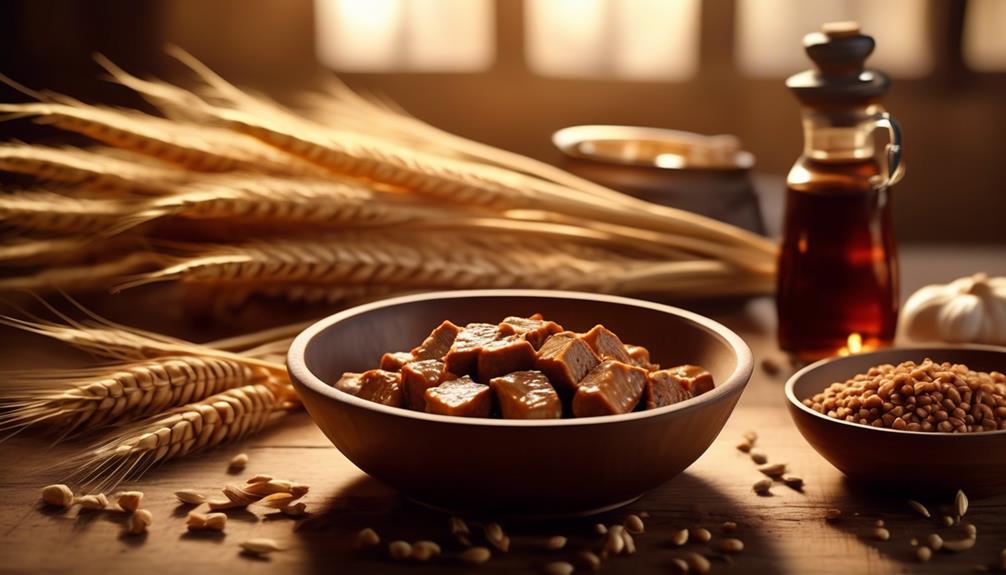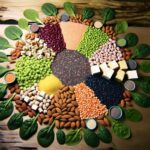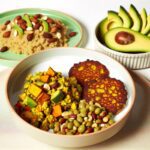Did you know that over the last decade, the popularity of seitan, a plant-based meat alternative made from wheat gluten, has surged by more than 300%? This ancient food, with its roots in Asian cuisine, has found a new lease on life in modern kitchens around the globe. As you explore the world of plant-based proteins, you'll discover that seitan's ability to mimic the flavor and texture of chicken makes it a favorite among vegans and vegetarians alike. Made by kneading wheat gluten with spices, nutritional yeast, and soy sauce, its versatility in absorbing flavors allows it to serve as a culinary chameleon. Whether you're a seasoned plant-based aficionado or curious about incorporating more meat alternatives into your diet, understanding the nuances of seitan's preparation, nutritional benefits, and culinary potential could open up a new dimension in your cooking. Let's embark on a journey to uncover the secrets behind this chewy, savory ingredient and how it can revolutionize your meals.
Key Takeaways
- Seitan is a plant-based meat alternative made from wheat gluten that mimics the flavor and texture of chicken, making it popular among vegans and vegetarians.
- Seitan is a versatile ingredient that can absorb flavors, making it a culinary chameleon and essential in plant-based cooking.
- Seitan is a high-protein meat substitute, with 25 grams of protein per 4-ounce serving, making it a staple in vegan and vegetarian diets.
- Seitan is embraced as a sustainable and ethical choice in the culinary world and is expected to integrate into mainstream dining as demand for sustainable food options surges.
What Is Seitan?
Seitan, a high-protein, wheat-gluten meat substitute, offers a versatile and meaty alternative for vegan and vegetarian dishes, enriching your culinary experience with its unique texture and flavor. Made from wheat gluten, the primary protein in wheat, seitan becomes a hearty choice for those seeking a plant-based protein source with a satisfying chew akin to meat. This vital wheat gluten is mixed with water and seasonings, then transformed into a wheat flour dough that's simmered in a flavorful broth, infusing it with depth and character.
Boasting an impressive protein content of 25 grams per 4-ounce serving, seitan stands out as a protein powerhouse. It's not just about the numbers; the quality of protein it offers makes it a staple in vegetarian restaurant meals and a sought-after ingredient in commercial meat substitutes. Whether you're crafting a homemade batch for that personal touch or exploring the myriad ways it can be cooked—baking, frying, pan-frying, stir-frying, or grilling—seitan seamlessly integrates into a variety of dishes. From stir-fries and stews to sandwich fillings, its adaptability is unparalleled, making it an essential element in the plant-based culinary realm.
The History of Seitan
Understanding the nutritional benefits and culinary uses of seitan sets the stage for exploring its rich history, tracing back to ancient Chinese cuisine. Over 1,500 years ago, chefs first harnessed the protein per wheat to create noodles, unknowingly paving the way for seitan, a vegan meat that would revolutionize plant-based diets. This meat alternative began its journey in Asian food traditions, particularly among Buddhist communities seeking nutritious, meat-free options.
The term 'seitan' itself was introduced to the world for the first time in 1961 by George Ohsawa, a visionary in the macrobiotic diet movement. By 1962, this unique plant-based meat was being produced and sold in Japan, showcasing its versatility and appeal beyond traditional Asian dishes. Its history in Western diets is relatively recent, with seitan making its debut in grocery stores in 1969, thanks to Erewhon, an American company that recognized its potential as a protein-rich, meat-free option for those catering to specific dietary needs, including diabetics advised by doctors since the 1830s.
Today, seitan's legacy continues as a beloved meat alternative, celebrated for its rich history and nutritional profile, making it a staple in vegan and vegetarian diets worldwide.
How to Make Seitan
Crafting seitan at home starts with mixing seasoned wheat gluten into a versatile dough, offering a culinary adventure into the world of high-protein, plant-based meats. This journey into making seitan not only enriches your cooking repertoire but also allows you to serve nourishing, meat-free delights to your loved ones. Here's a simplified recipe to guide you:
- Create the Dough: Mix 1 cup of vital wheat gluten with spices of choice, a tablespoon of nutritional yeast for a cheesy flavor, and gradually add water until you form a firm dough. The trick lies in finding the perfect balance – not too sticky, not too dry.
- Knead and Cook: Knead your dough for a few minutes to develop the gluten strands, then simmer it in a flavorful vegetable stock mixed with a dash of soy sauce. This cooking broth infuses your seitan with depth and umami, transforming it into a succulent delight.
- Storage and Usage: After cooking, store your seitan in the cooking broth within an airtight container. It'll last about five days in the fridge or can be frozen for three months. Now, you're ready to bake, fry, or grill it as you please, exploring endless culinary possibilities.
Cooking Techniques
Exploring a variety of cooking techniques can enhance seitan's flavor and texture, making it a versatile addition to your plant-based culinary arsenal. Once you've finished simmering your seitan in a flavorful broth, often infused with liquid smoke or baking powder for added depth, it's ready to be transformed using several methods.
| Technique | Description | Tips |
|---|---|---|
| Air Fry | Achieves a crispy exterior while keeping the inside moist. | Use nonstick spray for even cooking. |
| Pan Fry | Provides a golden crust and rich flavor. | Moderate heat prevents sticking. |
| Deep Fried | Creates a crunchy texture, perfect for mock meats. | Drain on paper towels to remove excess oil. |
| Bake | Offers a chewier texture, ideal for slicing or dicing into recipes. | Low and slow baking preserves moisture. |
Each method brings out a different aspect of the cooked seitan, from the crispy, addictive bite of deep-fried pieces to the tender chewiness of baked seitan. Experimenting with these techniques allows you to tailor the texture and taste to suit any dish, enriching your culinary creations and delighting those you serve with your plant-based offerings.
Storing Seitan Properly
After mastering various cooking techniques to elevate the taste and texture of your seitan, it's crucial to learn how to store it properly to maintain its savory goodness. Whether it's your first batch or the best seitan recipe ever, how you store it can make all the difference.
Here are three key steps to ensure your seitan retains its flavor and texture:
- Keep it in an airtight container with its cooking broth. Once your seitan is fully cooked and cool enough to handle, immerse it in its cooking broth within an airtight container. This method keeps it moist and well-flavored, mirroring the nutrition facts your recipe calls for.
- Refrigerate or freeze for longevity. You can refrigerate homemade seitan for up to five days. For longer storage, seitan freezes well for up to three months when kept in sealed containers or resealable bags. This prevents freezer burn and maintains quality.
- Portion before freezing. If your seitan is destined for the freezer, consider portioning it beforehand. This allows for convenient use in future recipes without needing to thaw the entire batch, aligning perfectly with a plant-based lifestyle that desires serving others efficiently.
Seitan Vs. Tofu Vs. Tempeh
In the world of plant-based proteins, seitan, tofu, and tempeh stand out as versatile staples, each offering unique textures and flavors to elevate any dish. Seitan, crafted from seasoned wheat gluten, brings a meaty texture that's perfect for those vegan chicken recipes craving a hearty bite. It packs a protein punch with 25 grams per 4-ounce serving, making it a go-to for nutrition-focused meals.
Tofu, a smooth product born from condensed soy milk, and tempeh, a dense, fermented soybean patty, diversify the vegan palate. While tofu's silky consistency blends seamlessly into smoothies and desserts, tempeh's robust form stands up to grilling and frying, offering a nutty depth to your dishes.
Whether you're whipping up a quick stir-fry or a slow-cooked stew, these natural foods ensure you're serving not just meals, but moments of health and happiness. Each brings its own nutrition info to the table, with seitan excelling in protein and tofu and tempeh offering a balance of fiber and minerals. So, as you explore vegan recipes, remember these three are more than just ingredients; they're the building blocks of a compassionate, healthful culinary journey.
Nutritional Benefits
While seitan, tofu, and tempeh each bring their own unique flavors and textures to the table, let's focus on the nutritional powerhouse that is seitan and its myriad health benefits. Seitan, often hailed as a staple in plant-based diets, packs a protein punch with about 25 grams of protein per 4 ounce serving. This makes it an excellent choice for those looking to fuel their bodies with high-quality, plant-based protein.
Here are three key nutritional benefits of seitan:
- High in Protein: With 25 grams of protein per serving, seitan is a robust source of plant-based protein, vital for muscle repair and growth.
- Heart-Healthy: It's low in fat and free from cholesterol, supporting a healthy heart and cardiovascular system.
- Rich in Iron: Offering about 15% of the recommended daily intake per serving, seitan helps in preventing anemia.
You can easily incorporate seitan into your meals by cooking it in vegetable broth, seasoning with liquid aminos, garlic powder, and onion powder to enrich its taste. Whether you're crafting a savory stir-fry or a hearty stew, seitan's versatility makes it a nourishing and flavorful addition to your food repertoire.
Versatile Recipes
Exploring the culinary versatility of seitan opens up a world of flavorful, plant-based recipes that cater to any palate. With a basic recipe, you can embark on crafting homemade seitan, a high-protein, meaty alternative that's easy to make and infinitely adaptable. This foundation recipe makes it simple to customize your batch with various flours and seasonings, ensuring every dish you create is unique and satisfying.
For those eager to try your recipe, seitan's robust texture makes it perfect for frying, grilling, or baking. Whether you're aiming to make vegan steaks, stir-fries, or savory stews, seitan integrates seamlessly, absorbing flavors and adding a satisfying chew. Don't hesitate to fry the seitan for a crispy exterior that rivals any meat-based counterpart.
Versatile recipes that use seitan are not just about replacing meat; they're about celebrating the diversity of plant-based cuisine. From traditional dishes reimagined to innovative creations, the possibilities are endless. Let your culinary creativity flow, and remember, the best part of cooking with seitan is the joy of sharing your delicious, compassionate meals with others.
Flavoring and Seasoning
After mastering the art of crafting homemade seitan, you'll find that the real magic happens when you experiment with its flavoring and seasoning. Seitan is made versatile by the myriad of ways you can enhance its taste to complement any dish you're preparing to serve. Whether you're making seitan from scratch for the first time or looking to refine your recipe today, incorporating a personalized touch with spices and seasonings will elevate your culinary creation.
Here are three key tips to enrich your seitan's flavor profile:
- Incorporate Umami: Use umami-rich ingredients such as miso paste or tamari in your marinade. This will add a depth of flavor that's hard to achieve with salt alone.
- Season Generously: Don't shy away from using a mixture of spices like smoked paprika, garlic powder, and onion powder in powdered form. They blend seamlessly into chickpea flour or your base mixture, ensuring every bite is packed with flavor.
- Marinate for Depth: Before you cook or use the seitan, let it marinate in a concoction of soy sauce, vinegar, and your choice of spices. This not only tenderizes but also infuses it with complex flavors.
Future of Seitan in Cuisine
As the culinary world embraces more sustainable and ethical choices, seitan stands out as a versatile and protein-rich meat alternative poised for widespread popularity. With its meaty texture and ability to soak up flavors, seitan is at the forefront of culinary innovation, offering chefs and home cooks alike a canvas for creativity in plant-based cooking. It's not just about substituting meat; it's about redefining what vegetarian and vegan dishes can be.
Looking ahead, the future of seitan in cuisine shines brightly. As demand for sustainable food options surges, seitan's role as a meat substitute is set to expand, integrating into mainstream dining with ease. This growth is fueled by a collective yearning for ethical, plant-based protein sources that don't compromise on taste or texture. Expect to see seitan take center stage in innovative recipes and fusion dishes, pushing the boundaries of traditional cooking techniques.
Moreover, efforts to develop gluten-free seitan alternatives promise to widen its appeal, ensuring that even more people can enjoy this sustainable food option. Alongside the rise of convenient, pre-made seitan products, there's a new wave of culinary creations on the horizon. Seitan's flexibility and nutritional profile make it an invaluable ingredient in the evolving landscape of meat alternatives, heralding a future where plant-based cuisine is not just an option but a preference for many.
Frequently Asked Questions
Is Seitan Good or Bad for You?
Seitan's good for you if you're not gluten-sensitive. It's a solid plant-based protein choice, enhancing your diet diversity. Just balance it with other nutritious foods, and you're on your way to healthful eating.
Is Seitan Better for You Than Tofu?
To tackle tofu versus another option, it's crucial to consider your culinary canvas. One boasts a bounty of protein but packs gluten, while tofu tempts with soy. Both bolster dishes, but dietary needs dictate the decision.
What Is Seitan Made Of?
You're exploring a plant-based meat alternative crafted from wheat gluten. It's mixed with spices, nutritional yeast, soy sauce, and vegetable stock to create a meaty texture. Ideal for various recipes, it caters to compassionate cooking.
What Does Seitan Actually Taste Like?
You'll find it has a savory, umami flavor, much like chicken or beef. Its dense, chewy texture offers a satisfying bite. Plus, it's great at soaking up flavors, making it incredibly versatile in dishes.







